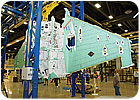
Lockheed Martin Corp. is no stranger to using innovative methods for increasing manufacturing output. During WWII, Lockheed used ideas from the automotive industry to transform the nature of aircraft production.
In 2010, the company repeated that strategy to reduce the cost of its F-35 Joint Strike Fighter. To lower the cost of wing assembly, Lockheed’s production engineers are using the FAStplant overhead conveyor, which was originally conceived to help automotive OEMs cope with changing production demands for final assembly.
Made by Dürr Systems, FAStplant transports partially completed wings between assembly stations to optimize material flow. Lockheed’s engineers chose the conveyor for three reasons: It adapts easily to product and process changes; it requires little infrastructure commitment; and it has an easy-to-maintain Twin Trolley System (TTS) belt drive system.
FAStplant’s adaptability stems from its modularity. Similar to building blocks, the conveyor’s layout can be changed easily because of the standardized interface between components. If Lockheed decides at some point to add more workcells or reconfigure the existing process flow, it can simply move existing modules or add new modules as required.
The conveyor’s controls are also modular. Although there is only one PLC and main control cabinet, each module is a discrete unit rather than a set of components. Programming for each module is broken into blocks called tech schemes. When a new module is added to the system, the tech scheme is pasted into the program, and the system is ready to run. Rather than running a cable to each module from the main control panel, the units are designed to daisy chain into the adjacent modules.
FAStplant is a compromise between floor and overhead conveyor systems. Most of the equipment for transport and utility supply is out of the way of floor-based operations, and the conveyor is supported by its own columns. As a result, other than the area directly under the conveyor, the system’s building crane has access to the entire floor area. If access is a problem, special C-shaped load bars can be used for handling loads directly under the conveyor track.
To provide a smaller crane that covers each assembly station, Lockheed did adapt some parts of the F-35 wing assembly line. The runways mount directly on the top of the structure. The steel that supports the conveyor is low enough to allow the empty crane hook to pass over, allowing the crane to be used on either side of the workstation. In places where the line runs parallel to itself, a small bridge is included to allow one crane to move across to the other part of the line as a backup.
Besides sealed bearings, the system features polymer wheels on extruded aluminum track, rather than hardened steel rollers in hot-rolled steel beams or channels. This combination results in smooth and quiet motion, and a surface clean enough to not require catch pans.
Lockheed did not require any utilities supplied to the carrier, although it is possible to provide electrical contacts to power the moving carrier. The TTS drives the carriers via timing belts mounted above the track. These belts are spaced such that there is always one spring-loaded drive dog in contact with a belt along any point on the line.
The TTS drive system also is forgiving enough that slight differences in speeds and tooth synchronizations do not cause any noticeable effect as trolleys get handed off from one belt to the next.
For more information on overhead conveyors, call 248-745-8500 or visit www.durr.com.

